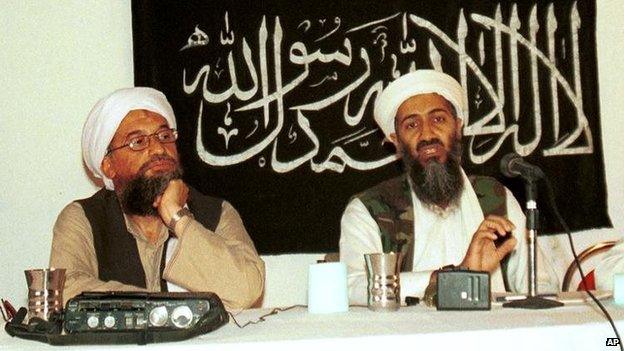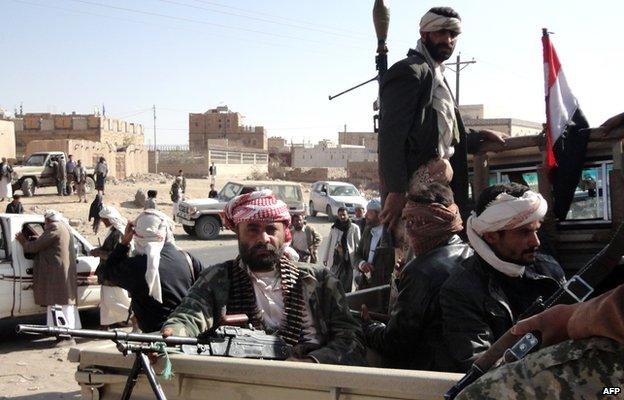A history of modern jihadism
- Published

Jihadists see violent struggle as necessary to eradicate obstacles to restoring God's rule on Earth and defending the Muslim community, or umma.
Here, BBC Arabic's Murad Batal al-Shishani looks at the evolution of the jihadist movement over the past four decades.
1970s: Revolutionaries
The modern jihadist movement emerged in the late 1970s, when several groups began campaigns to overthrow the Arab World's regimes and establish Islamic states.
A booklet entitled Al-Farida Al-Ghaiba (The Neglected Duty) served as an important guide for them.

Mohammed Abdul Salam Faraj's group, al-Jihad, assassinated Egyptian President Anwar Sadat in 1981
The Egyptian author, Mohammed Abdul Salam Faraj, argued that Muslims had neglected jihad in the sense of violent struggle, focusing instead on the inner struggle against their baser instincts.
Faraj also argued that the fight against the "near enemy" - local, Muslim regimes - was more important than the fight against the "far enemy" - external, non-Muslim threats.
His group, al-Jihad, assassinated Egypt's President Anwar Sadat in 1981.

1980s: Afghanistan

The mujahideen fought Soviet forces and their Afghan allies throughout the 1980s
Following Sadat's death, Egyptian security forces launched a crackdown on jihadists and they started to flee the country.
The most attractive place for them at that time was Afghanistan, where a jihadist battlefield was in the making following the 1979 Soviet invasion.
The US and its Gulf Arab allies were encouraging young Muslims to go there to wage war against the forces of the Soviet Union and the local communist government it backed.
Those who travelled were also motivated by a fatwa (religious rulings) issued by the Jordanian-Palestinian cleric, Abdullah Azzam.
Azzam considered jihad in Afghanistan - or any other Muslim land which faced aggression - an individual duty that had be fulfilled by every able Muslim.

1990s: Al-Qaeda

Ayman al-Zawahiri and Osama Bin Laden sought sanctuary from the Taliban in Afghanistan
Azzam was Osama Bin Laden's mentor and the name of his group, al-Qaeda - which means "the base" in Arabic - came from an article he wrote for a jihadist journal.
He suggested creating a base for the thousands of foreign fighters - known as the mujahideen - whom he recruited to fight in Afghanistan.
The cleric was killed in a car bombing in Pakistan in 1989 - it is still not known who was responsible - but his ideas gave birth to what it is now called "global jihadism".
After the Soviet withdrawal in 1989, many jihadists left Afghanistan.
Some of them, buoyed by their triumph over a superpower, wanted to repeat that in their home countries.
In Egypt, tourists were targeted, clashes were reported in Libya, and a bloody civil war erupted in Algeria after Islamists were prevented from taking power after winning elections.
Other former mujahideen wanted to repeat the experience of jihad and travelled to Bosnia, Tajikistan and Chechnya to defend local Muslims against non-Muslim armies.

The World Islamic Front's declaration of war was published in a pan-Arab newspaper in 1998
Then in 1998, the revolutionary jihadism of the Egyptian mujahideen and the fundamentalist Salafism of those from Saudi Arabia combined to form a new movement, the so-called "World Islamic Front for Jihad against the Jews and the Crusaders".
In 1998, it issued a declaration signed by Bin Laden and the Egyptian Ayman al-Zawahiri declaring total war against the United States and its allies.
It signalled the start of a new fight against the "far enemy" and later that year al-Qaeda bombed the US embassies in Kenya and Tanzania.

Early 2000s: 9/11

The 11 September 2001 attacks killed almost 3,000 people and triggered the invasion of Afghanistan
On the morning of 11 September 2001, al-Qaeda members hijacked four planes and used them to carry out unprecedented attacks on the US that killed almost 3,000 people.
Within a month, the US and its allies responded by invading Afghanistan, overthrowing the Taliban regime that had given sanctuary to al-Qaeda's leaders.
The group's members and the jihadists they had trained over the years and sent back to their home countries subsequently launched a series of spectacular attacks across the world, most notably in Bali in 2002, Casablanca in 2003, Madrid in 2004, and London and Amman in 2005.
The US-led invasion of Iraq in 2003 also helped produce a new generation of jihadists.

Abu Musab al-Zarqawi's brutal tactics alienated Iraq's Sunnis and drew criticism from al-Qaeda leaders
The Jordanian militant, Abu Musab al-Zarqawi, formed an offshoot of al-Qaeda in Iraq (AQI) that became notorious for its brutal tactics, particularly the videotaped beheadings of civilians.
Zarqawi was killed in a US air strike in 2006, the year before a US troop surge and dwindling support from Sunni tribesmen saw AQI put on the defensive.

Late 2000s: Offshoots

Al-Qaeda in the Arabian Peninsula has thrived in Yemen, where large areas are outside government control
The latter half of the decade saw al-Qaeda offshoots formed elsewhere in the Middle East and North Africa.
In Iraq, AQI formed a militant umbrella group called the Mujahideen Shura Council, which shortly afterwards became known as Islamic State in Iraq (ISI).
Meanwhile, Saudi and Yemeni jihadists formed al-Qaeda in the Arabian Peninsula (AQAP).
Algerian jihadists from the Salafist Group for Preaching and Combat (GSPC) declared their allegiance to Bin Laden and created al-Qaeda in the Islamic Maghreb (AQIM). They also expanded their activities into the Sahel region south of the Sahara Desert.
The Somali jihadist group, al-Shabab, vowed to "connect the Horn of Africa jihad" to the one led by al-Qaeda in 2010, declaring allegiance two years later.

2010s: Arab Spring

Thousands of foreigners have travelled to Syria to wage jihad against President Bashar al-Assad's forces
In 2011, Bin Laden was killed in a US special forces operation in Pakistan.
In addition to losing its leader that year, al-Qaeda also faced another challenge - the Arab Spring.
The uprisings that led to the overthrow of the leaders of Tunisia, Egypt, Libya and Yemen saw the jihadist network and its offshoots marginalised by groups who advocated peaceful change.
But Syrian President Bashar al-Assad's brutal response to the uprising in his country eventually led to the creation of a new battlefield that attracted jihadists from all over the world.
One unexpected development has been the emergence of a challenger to al-Qaeda for leadership of the global jihadist movement.

Islamic State leader Abu Bakr al-Baghdadi has been proclaimed "caliph"
In 2013, ISI leader Abu Bakr al-Baghdadi announced the merger of his group and al-Qaeda's affiliate in Syria, al-Nusra Front, and the creation of Islamic State in Iraq and the Levant (Isis or Isil).
But Bin Laden's successor, Ayman al-Zawahiri, and the leader of al-Nusra rejected the move, triggering deadly infighting and later al-Qaeda's disavowal of Isis.
Isis subsequently seized control of large swathes of Syria before launching an offensive in Iraq in 2014 that saw it capture the second city of Mosul and declare the creation of a "caliphate".